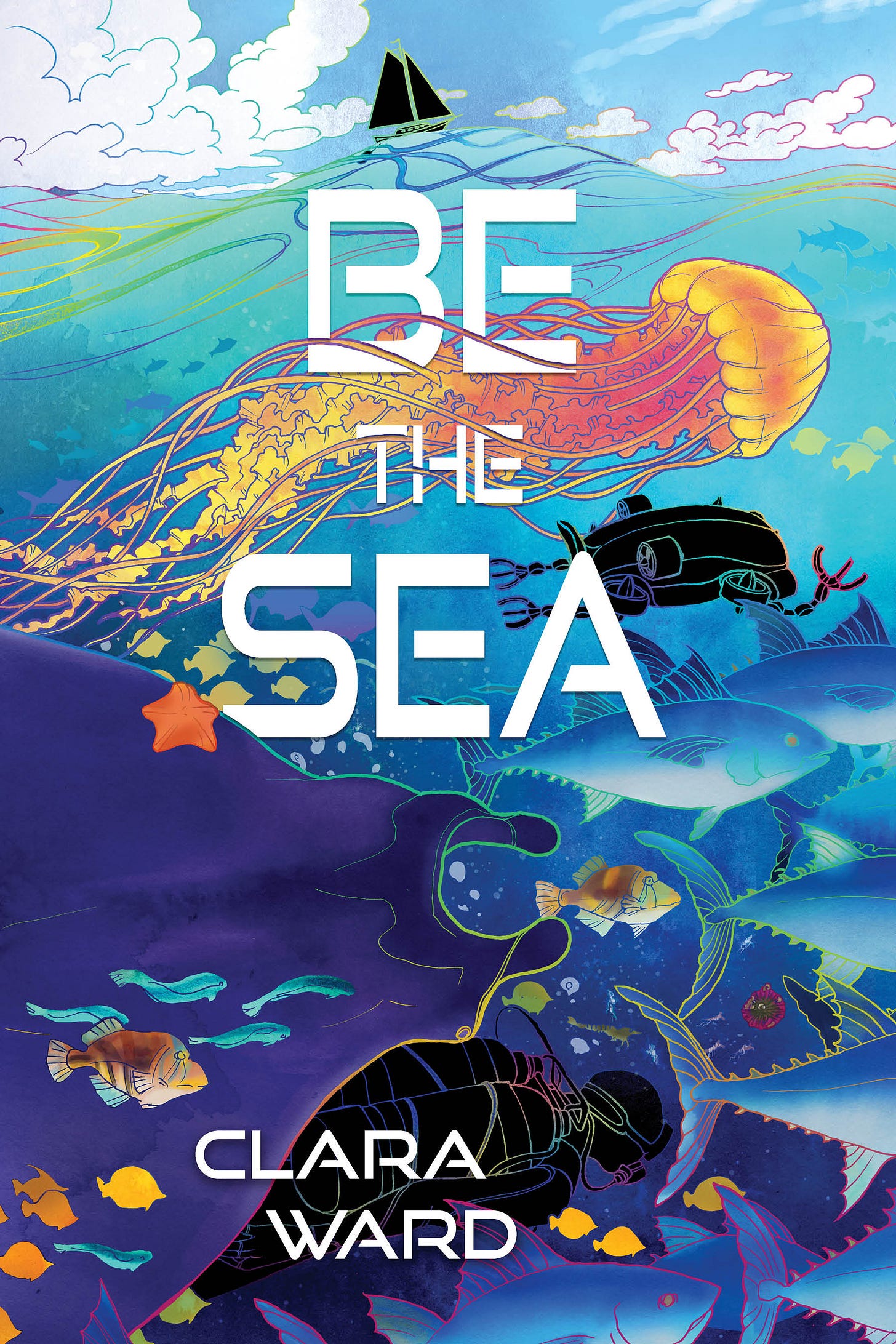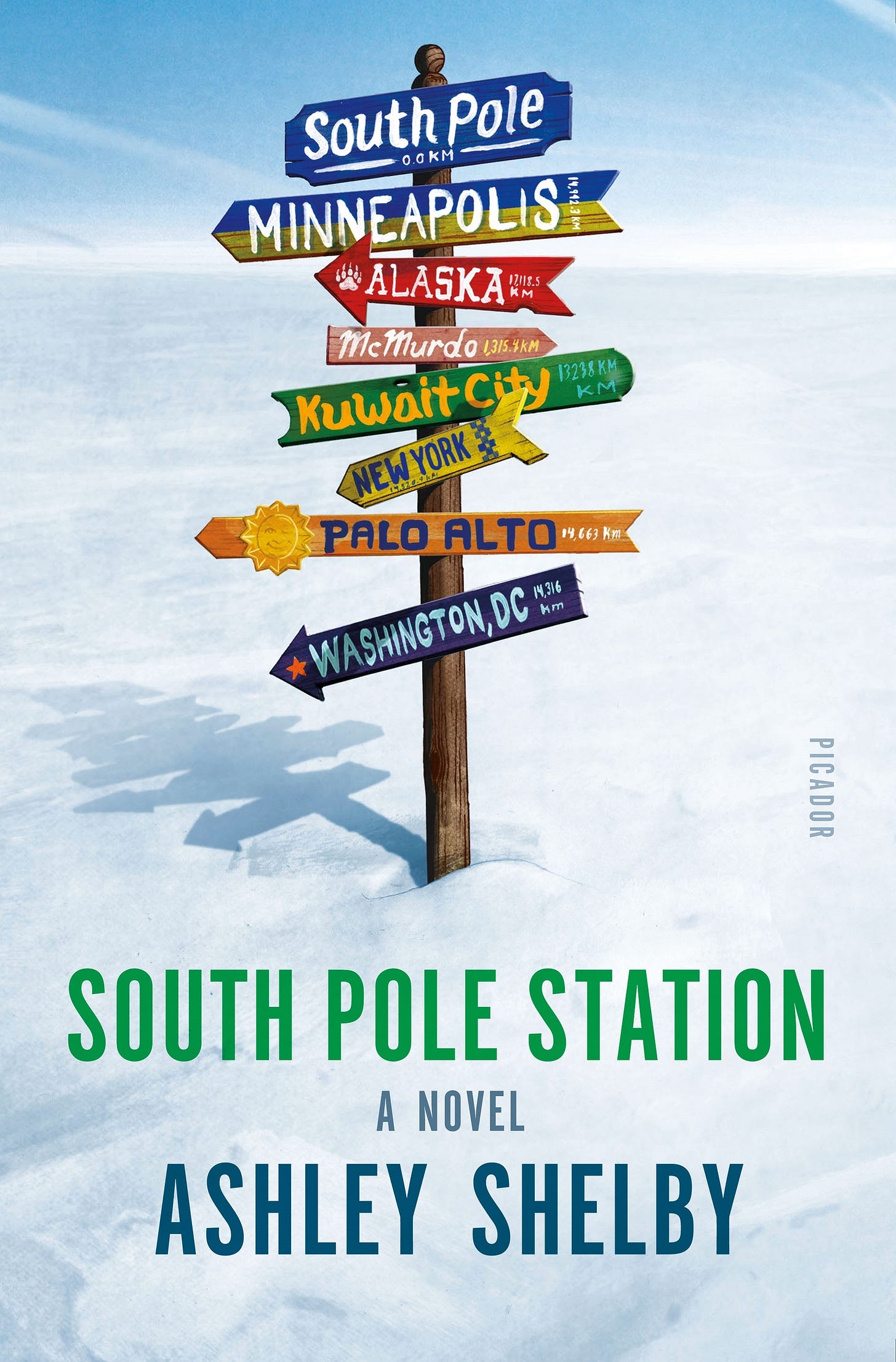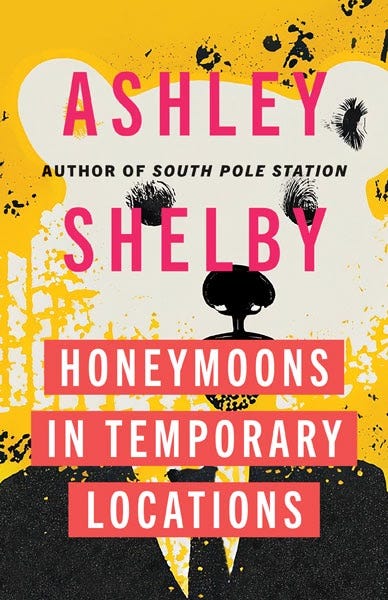Perspectives and Speculation in Climate Fiction
A conversation between Clara Ward and Ashley Shelby
Earlier this year, Clara Ward published Be the Sea, a queer solarpunk sci-fi novel set on a boat in the Pacific, and Ashley Shelby came out with Honeymoons in Temporary Locations, a collection of experimental, multimedia climate stories.
When they both joined the Climate Fiction Writers League, Wren James said, “Super excited to connect you both! I'd love it if you could write a piece together for the newsletter talking about both your books.” Building on that enthusiasm, Ward and Shelby paired their perspectives to answer four questions that they hope will inspire reflections for writers and readers alike.
Q: Was there a specific event that started you writing climate fiction or inspired your latest work?
CLARA WARD: My earliest memories are of the ocean. I was born in Kāneʻohe, Hawai’i, at a time when sewage discharge was the main threat to local coral reefs. I may not have understood environmentalism back then, but I understood people could harm the ocean. Or they could fight to protect it.
My latest novel, Be the Sea, is set in 2039 when the focus has expanded from sewage discharge to the impacts of plastic pollution and climate change. My point of view character, Wend, was born in Kāneʻohe in 1972 and shares my long history of concern for the ocean. Wend sees humans as both threats and protectors, pulling together a chosen family who fight to preserve the ocean using photography, science, entrepreneurship, litigation, and education.
ASHLEY SHELBY: I was an environmental journalist before turning to fiction, and back in 2004 was reporting on Exxon's refusal to pay punitive damages to the people of Prince William Sound, who had been devastated by the Valdez spill in 1989. At that time, Exxon had been trying to discredit a government scientist named Jeff Short, whose research demonstrated that there was still substantial oil in the Sound. Exxon had hired its own scientist to dispute Short's research and tarnish his professional reputation, even though Short's research was impeccable. I never forgot the experience of reporting on Exxon--and learning the lengths that a corporation would go to in order to deny science if it protected its bottom line.
When I started writing fiction, I turned that experience into a character in my first novel, South Pole Station, which has been called "historical climate fiction" because it is set in 2002-2003 at the Amundsen-Scott Antarctica Research Station and features a climate change-denying scientist. The early aughts was a time when the "merchants of doubt" were hard at work to discredit the fact that the planet was warming and that the warming was human-caused. Exxon was a major player in that effort. I didn't realize at the time I was writing what people call climate fiction, but the experience of writing about bought science and climate change solidified my interest in writing about our changing world, examining the motives of those who deny science, and speculating about what a future so heavily influenced by denialism, an "infinite growth" economic model, and a billionaire ruling class might look like.
Q: Does your approach to storytelling affect the way you portray climate issues?
SHELBY: This is a great question. I wrote a little bit about this in a piece I wrote for LitHub called "Dangerous Solastalgia: On Writing in the Midst of Climate Grief." My approach to storytelling had been fairly traditional prior to the publication of my most recent book, Honeymoons in Temporary Locations. My novel South Pole Station is a mainstream, fairly traditionally crafted novel featuring characters living in a real-life setting and informed by real events. I found writing about historical climate change denialism worked well in that form. But when I tried to write a second novel about where we are in this moment when it comes to climate change, the old tools failed me. Dialogue, setting, realistic scenes--none of it seemed up to the task of expressing what I wanted to express--which was all my complicated feelings about climate change as it unfolds all around us. I knew that, for me, a novel like South Pole Station where a plot unfolded chronologically, characters had "arcs," and settings didn't change much, would not allow me to convey anything meaningful. I felt like I had to write in a different "language" than the one I was used to.
For me, that language was speculative informed by real-life events, and contained in various narrative forms and frames. I couldn't write a set-piece about my profound sorrow about what climate change is doing to our blameless and voiceless fellow animals, but I could write a first-person speculative nautical tale set in a future liquid Arctic but written from the 1800s. I couldn't express the horror I felt contemplating the collapse of agricultural sectors, but I could write a menu for a Starbucks-like chain of cafes selling "coffee-like drinks." And I could think of no way to express the dark humor of a pharmaceutical firm developing an "anti-solastalgia" drug to help people stop caring about the destruction of the planet as a traditional premise, but I could imagine the secret marketing plan the company would write up to sell "Climafeel." These are all "stories" in Honeymoons in Temporary Locations. Sometimes you have to change the way you tell stories if the old way doesn't work, even though it's a risk. [See the end of the newsletter for an extract about climafeel.]
WARD: I’ve been told I approached writing backward, because I began by writing novels, before branching out into short stories. But even as a small child, I loved stories within stories, especially when characters broke through preconceptions to speak their own truth. Whether my characters are locals or outsiders drawn by scientific curiosity or inexplicable forces, they naturally explore their individual perspectives and challenges alongside the facts of their situations.
Many of the stories I’ve enjoyed recently have been labeled cozy or hopepunk, and I’ve always appreciated seeing characters in their quiet moments, creating or cooking together and then sharing good food (especially chocolate!). While there are parts of Be the Sea that are decidedly not cozy, I doubt readers could appreciate the characters or their relationships without sharing those comfortable moments. Especially when writing about the near future and climate change, I believe those quiet moments offer readers time to reflect and re-energize (as in real life!).
Q: How do you stay hopeful when researching and writing about climate change in the near future?
WARD: As an educator and volunteer, I have been privileged to work with young people who share their enthusiasms and creativity with me alongside their concerns for a future that will weigh heaviest on them. In 2009 the FIRST Lego League robotics theme was “Climate Connection.” I worked with grade-school students in the Bay Area who built Lego houses designed to float above their foundations and then resettle when flood waters subsided. At least two of those students, now in their twenties, went on to work in green energy/design. When I lose faith in my generation, I look to theirs and “just keep writing” (to paraphrase Finding Nemo, a movie I also discovered with that generation).
SHELBY: Honestly, it's hard. The researching is particularly hard, because there's nowhere to hide. The news is mostly bad. Things are continually lost. No one in power seems to be listening. I have to actively search for "good climate news" to make sure I don't succumb to hopelessness. I also find hope in writers like you, who have the imagination and the wisdom to see a way forward. There are futures that aren't worst-case scenarios, where social and environmental justice hold us together as we navigate the world as it changes around us. It's easy to forget that all futures are possible when you're so fearful of the one everyone tells you is a certainty. The other place I find my hope is in my children and the young people who are bravely fighting for their future, including the young protestors who put themselves in great peril to get the world to pay attention.
Q: What do you hope readers take away from your stories?
SHELBY: As a writer, I know I have no control over what my readers take away from my stories. What I hope for, though, is that climate change becomes something they think about, yes, but also talk about. Eric Holthaus, a climate communicator and meteorologist, has said that one of the most effective things we can do to help combat climate change is not to recycle or buy electric cars, but to simply talk about climate change with our family, our peers. Right now it's almost rude to talk about climate change in mixed company, as if we're talking about death. But a comment here, a comment there, can normalize the discussion of this existential issue.
A grandparent having coffee with her peers might say something like, "It's 85 in October here in Minnesota, and it seems we've had several falls like this. Climate change is starting to impact the seasons, and I can't help but think about how this will impact my grandkids. I'm going to look for a candidate who takes climate change seriously." And that's it. Now it's in the mind of other people--no lecture required. So if my book can get someone thinking and then talking about climate change, that would make me happy.
WARD: While I pour my hopes and fears into my writing, I trust each reader to take what they will from it. As a neurodivergent, queer, nonbinary writer, I know some readers come seeking representation. They need to see someone like them on the page. Others may challenge themselves to read a queernormative story for Pride Month or a main character with they/them pronouns for Trans Awareness Week. What I offer in my stories are the most authentic, complete characters I can describe. Then I show how each of them can make a difference in the lives of other humans as well as our global ecosystem. Even if some readers forget every eco-fact embedded in the story, I hope they’ll be inspired to take some form of action.
Find out more about Be the Sea and Honeymoons in Temporary Locations, or read on for an extract.
Ashley Shelby is the author of Honeymoons in Temporary Locations and South Pole Station. A former environmental journalist, Ashley's short fiction essays, and reviews have appeared in the New York Times Book Review, LitHub, Slate, Salon, Audubon, and other outlets. Her original reporting on the Exxon Valdez litigation was published in the Nation. Ashley lives in the Twin Cities with her family. More information can be found at www.ashleyshelby.com
Clara Ward lives in Silicon Valley, California on the border between reality and speculative fiction. Their latest novel, Be the Sea, features a near-future voyage across the Pacific, chosen family, and sea creature perspectives, while delving into our oceans, our selves, and how all futures intertwine. A passion for environmentalism and diverse worldviews extends to their shorter works featured in The Neurodiversiverse: Alien Encounters, Small Wonders, and Tales & Feathers by Augur. When not using words to teach or tell stories, Clara uses wood, fiber, and glass to make practical or completely impractical objects. More of their words along with crafted creations can be found at: https://clarawardauthor.wordpress.com
Extract from Honeymoons in Temporary Locations
Excerpt from “‘Incident on Yellowstone Trail’ Climate Crimes Files Podcast, Episode 276”
[JEN—advertisement]: Longtime listeners know that, like so many others, I struggle with solastalgia, the suite of mental and emotional disorders brought on by active and predicted climate change impacts. And while talk therapy does help, I still sometimes experience episodes of rage, forgetfulness, week-long depressive episodes, retroactive climate denial, even catatonia. Your basic solastalgia experience. But then my doctor suggested Climafeel, and my life changed completely. Taken once a day, Climafeel offers solastalgia sufferers the ability to face a changing world with fearlessness and stress immunity while retaining the emotional versatility needed to experience love, happiness, and, of course, hope. Since starting a course of Climafeel, my episodes have been cut in half. Instead of waking up in a state of fear and anxiety, I feel optimistic for the first time in years. It’s changed my outlook and provided me with the hope I need to wake up in the morning. In a world made strange—in a world defined by loss, a world that makes hope hard to come by . . . Climafeel can help. Now, back to the show.
Excerpt from “Mark” (a commercial script for the drug mentioned above)
[Sonic dread, in the form of a long, drawn-out violin tri-tone, begins the transition from Mark’s living room to a string of images and video clips. Violent wildfires sweetened with crackling sounds jump cut against film of massive flooding events in nondescript Midwestern towns, with people on roofs waving white pillowcases above their heads.]
NARRATOR (voice-over): In a world made strange.
[The iconic image of the St. Louis Arch knee-deep in the waters of the Mississippi cedes to public domain footage of the evacuation of Miami Beach.]
NARRATOR (voice-over): In a world defined by loss.
[Documentary stills of environmental refugees at a coastal evacuation terminal dissolve into shots of tinder-dry wheat fields, bleached reefs, and dead forests.]
NARRATOR (voice-over): In a world that makes hope hard to come by . . . Climafeel can help.
[Music transitions to cheerful major chords and the imagery shifts: a family picnicking; a couple gazing at each other over a candlelit dinner; cheerful teenagers on skateboards.]
NARRATOR (voice-over): Developed with you in mind, Climafeel offers the Impacted an opportunity to face their changing world with fearlessness and stress immunity while retaining the emotional versatility needed to experience optimism, affection, unparalleled focus, and productivity.
Vortex’s world-class geneticists have developed a biologic that eliminates fragility, polishes awareness, and offers anxiety-free living in a challenging environment.
Seamless adaptation is possible with Climafeel.
Writing NSW - Online Climate Fiction Course
2 – 8 April: Writing Compelling Climate Fiction
Temperatures are rising and catastrophic droughts, storms and bushfires are becoming more frequent and intense. It could be argued that today, all fiction is and should be climate fiction. Join trained biologist and award-winning writer Amanda Niehaus, to delve into the world of climate fiction.







https://www.amazon.com/gp/product/B00BLMXX1O?ref_=dbs_p_pwh_rwt_cpsb_cl_1&storeType=ebooks
https://www.amazon.com/dp/B00AIZ3L4E